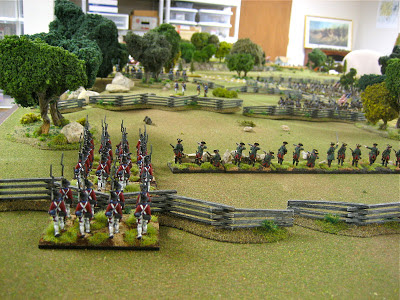I am a little bit disappointed that I was not able to hit my target of 100 blog posts in 2012. I fell short with only 90 posts by the end of the year. I started out 2012 fairly strongly, but then tailed off the production during the Spring and Fall months. In the end, however, I decided not to post just for the sake of posting and increasing the count, but simply post an article when I had something to say.
Now that we have turned the page on 2012 and enter the New Year, I am starting to think about the wargame projects that I want to tackle over the next twelve months. These include:
Seven Years War BAR sized Armies (1:10 ratio)
British Cavalry - 2 to 4 squadrons of heavy Horse or Dragoon Guards
British Artillery - a pair of 12-pounders
Austrian Cuirassiers - add another squadron of Hinchcliffe cuirassiers to bring a unit up to 60 figures.
Croats - one never has enough Croats.
Austrian Artillery - add a couple of 12-pounders and 6 crew per gun model
Prussian Musketeers - add IR13 Itzenplitz to replace the same unit that I sold two years ago
Prussian Dragoons - perhaps start on the 10 squadron Bayreuth Dragoons (120 figures)
Prussian Pontoon Corps - I have two Berliner Zinnfiguren pontoon wagons
Seven Years War - Minden Figures (1:20 ratio)
Prussian cuirassier regiment - 32 figures
Prussian fusilier battalion IR49 - 30 figures, second battalion to complete the regiment
Prussian hussar regiment - 32 figures, kolpaks, so probably HR1 or HR2
Austrian cuirassier regiments - 2 regiments of 32 figures
Austrian hussar regiment Baranyay (green dolman/pelisse, sky blue breeches
Austrian supply wagons to go with each artillery piece
BAR Napoleon - Peninsular War in 1:10
British 88th Regiment (Connaught Rangers) - Elite Miniatures -- 84 figures
British 42nd Regiment (Black Watch) - Connoisseur Miniatures -- 100 figures
French chasseur a cheval regiment - 36 figures in three squadrons, old Elite Miniatures.
American Revolution (AWI) in 1:10 ratio - Fife & Drum Miniatures
British infantry regiments - 3 regiments of 32 figures
Continental infantry - 3 regiments in hunting shirts (20/24 or 30 figures each)
British 16th Light Dragoons - 36 figures, once the figures are sculpted and in production,
Odds and Ends
Claymore Castings Otterburn range - I would like to paint some of these terrific looking castings. Maybe 1 to 2 "battles" of 24 figures of Scottish infantry and some mounted knights once they become available. A friend plans to start a Medievil campaign in 2013 and I would use the figures for this project.
That seems like a fairly ambitious list of things to paint. It is more of a wish list than a road map as I doubt that I can paint that many figures in one year. Well, I used to be able to paint that many figures in one year, but I think that Mrs. Fritz would not approve. I quite agree with her on that score.
I also want to start doing some more solo AWI and SYW battles using my 1:20 ratio armies of Fife & Drum and Minden Miniatures, respectively. I will probably take the AWI collection to several conventions in order to stimulate some figure sales, but the SYW collection will not make it into the public arena for awhile, I am afraid.
Fife & Drum Range: I am guessing that I will be able to add two more sets of 16 figures over the course of 2013, depending on Richard's schedule. In that event, I would add some AWI cavalry to cover the British 16th Light Dragoons as well as some Continental cavalry in various head gear. The second set will likely see either more American militia, some special figures and more horses, or I could go with 6 to 8 personalities for each side.
I would like to be able to make it to Historicon in 2013, both to host some AWI games and to have a dealer booth at the show.
It looks like a very busy year ahead for me, to say the least.






























